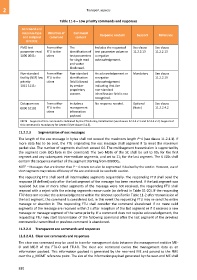Page 820 - 5G Basics - Core Network Aspects
P. 820
2 Transport aspects
Table 11-6 – Low priority commands and responses
Command and
response type Direction of Command Response content Support Reference
and assigned command content
OPCODE
PMD test From either The Includes the requested See clause See clause
parameter read FTU to the identification of test parameter values or 11.2.2.13 11.2.2.13
1000 00012 other test parameters a negative
for single read acknowledgement.
and vector
block read.
Non-standard From either Non-standard An acknowledgement or Mandatory See clause
facility (NSF) low FTU to the identification a negative 11.2.2.19
priority other field followed acknowledgement
1011 11112 by vendor indicating that the
proprietary non-standard
content. identification field is not
recognized.
Datagram eoc From either Includes a No response needed. Optional See clause
0000 10102 FTU to the management (Note) 11.2.2.4.2
other information
payload.
NOTE – Support of this command is indicated by the FTU during initialization (see clauses 12.3.4.2.1 and 12.3.4.2.2). Support of
this command is mandatory for Annex S (see clause S.4.3).
11.2.2.3 Segmentation of eoc messages
The length of the eoc message in bytes shall not exceed the maximum length P−4 (see clause 11.2.1.1). If
more data has to be sent, the FTU originating the eoc message shall segment it to meet the maximum
packet size. The number of segments shall not exceed 64. The multisegment transmission is supported by
the segment code (SC) byte in the command. The two MSBs of the SC shall be set to 002 for the first
segment and any subsequent intermediate segments, and set to 112 for the last segment. The 6 LSBs shall
contain the sequence number of the segment starting from 0000002.
NOTE – Messages that are shorter than P − 4 octets can also be segmented if desired by the vendor. However, use of
short segments may reduce efficiency of the eoc and should be used with caution.
The requesting FTU shall send all intermediate segments sequentially. The responding FTU shall send the
response (if defined) only after the last segment of the message has been received. If the last segment was
received but one or more other segments of the message were not received, the responding FTU shall
respond with a reject with the missing segments reason code (as defined in Table 11-20). If the requesting
FTU does not receive the acknowledgement within the timeout specified in Table 11-2 after transmission of
the last segment, the command is considered lost; in this event the requesting FTU may re-send the entire
message or abandon it. The responding FTU shall consider the command abandoned if no more valid
segments of the message are received within 2 s after reception of the last segment or if it receives a new
message or message segment of the same priority. If a command does not require acknowledgement, the
requesting FTU may start transmission of the following command after the last segment of the previous
command is transmitted or previous command is abandoned.
11.2.2.4 Transparent eoc commands and responses
11.2.2.4.1 Clear eoc commands and responses
The clear eoc command may be used to transfer management data between the management entities ME-
O and ME-R of the FTU-O and FTU-R. The clear eoc command carries the management data as an
information payload. This information payload is generated by the near-end ME and passed to the FME
over the γ_MGMT reference point. The size of the information payload generated by the near-end ME shall
810

